Stained glass, steeples and financial sustainability
The formerly enslaved artisans who constructed First African Baptist Church in Beaufort, South Carolina, sometime after the Civil War didn’t use nails. Metal was expensive and often hard to come by for Black builders less than a generation from bondage.
The Rev. Alexander McBride, First African’s senior pastor, explained how the laborers built the church in Gothic Revival style, noted for its signature pointed arches and windows. The current building replaced an antebellum praise house, an open one-room clapboard space with little furniture so the enslaved could engage in a more mobile, joyful service removed from white surveillance and sit-quiet worship styles.
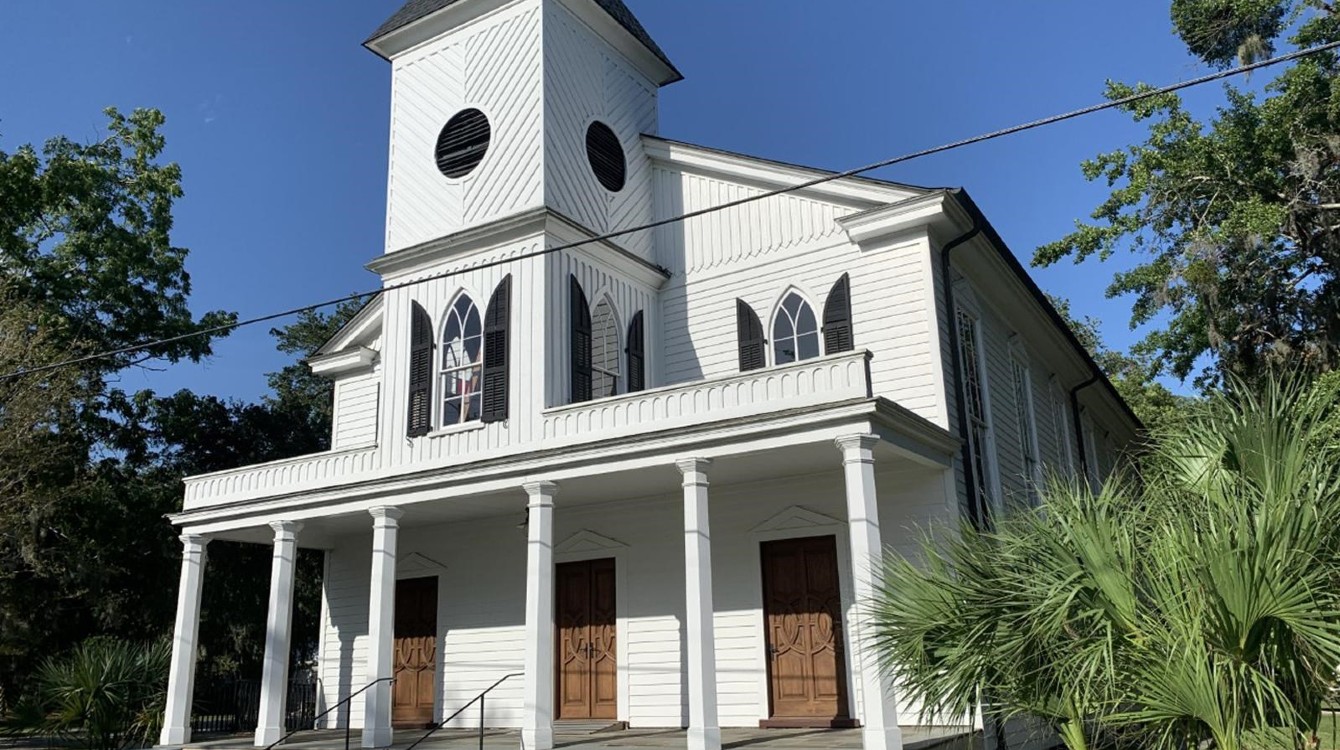
“They used the mortise-and-tenon method, where they interlock the wood. And this church has withstood every hurricane” that has rolled through the coastal city, said McBride, the 16th pastor at First African in its more than 150 years of existence.
And there have been many storms. An 1893 hurricane drowned many of the town’s Black residents, stranded in low-lying areas or swept to their deaths. But even that massive storm didn’t cause significant damage to the church, thanks to the unnamed craftsmen who may have lacked nails but had possessed the skill and wisdom to use the strongest joint known to woodworkers.
The church’s biggest current enemies are time, termites (which have eaten their way through some of the structure’s undercarriage) and moisture — largely unavoidable menaces for a century-old building in a humid seaside town.
Earlier this year, First African was among dozens of historically Black churches to win grants from the National Trust for Historic Preservation’s African American Cultural Heritage Action Fund. Those monies, through the Preserving Black Churches initiative — $4 million in this funding cycle — will support projects that recast their sites’ history through new interpretation or exhibits, grow capacity through staff hires and community outreach, and repair aging or damaged buildings.
Diversity of spaces
The grantees highlight the diversity of Black worship spaces and the history of how Black Americans have fought for religious freedom and built their own institutions amid racism and violence. They include institutions such as 16th Street Baptist Church in Birmingham, which just marked 60 years since the Ku Klux Klan bombing that killed four girls and damaged the church; the elegant Black-majority Basilica of St. Mary of the Immaculate Conception in Norfolk, Virginia; one-room churches built by hand and heart; and churches in places with historically small Black populations, such as Alaska and West Virginia.

“Black churches are living testaments to the achievements and resiliency of generations in the face of a racialized, inequitable society,” said Tiffany Tolbert, the Action Fund’s senior director for preservation. “They’re foundational to our Black religious, political, economic and social life.”
In some places, a church is the only building that remains as an artifact of a Black community that no longer exists. Scotland AME Zion Church in Potomac, Maryland, not far from the nation’s capital, is one such example from a community swallowed by encroaching development and urban sprawl.
Religion scholar C. Eric Lincoln once described the Black church as the unchallenged “cultural womb of the Black community.” Fellowship halls and sanctuaries in Black churches have long functioned as multipurpose rooms, where worship and politics meet. Churches like Beaufort’s First African have been incubators for Black social enterprise; during Reconstruction, First African was the site of a school for freed people, hungry for the literacy denied them during slavery.
Numerous historically Black colleges, civil rights protests and social movements trace their origins to Black pulpits and pews. Preserving church spaces can thus have a multiplying effect, documenting as well the stories of Black communities at large and the work of Black architects, artisans and mutual aid.
Worthy of preservation
It’s commonly said that the church is “more than the building,” yet buildings are material remnants of history and culture. What kinds of meaning do church buildings have for you?

That’s the case with the Halltown Memorial Chapel, built in 1901 not far from Harpers Ferry, West Virginia, where abolitionist John Brown and his band of brigands in 1859 had raided an arsenal in hopes of ending slavery. The one-room chapel is small, only about 40 feet by 50 feet, with room for 13 pews. It was built of rubble stone by church members, stone masons and laborers who also constructed a nearby turnpike or worked at the local paper mill, which has since closed. Services continued there for decades, only ceasing after World War II because of a dwindling congregation. After that, it hosted the occasional gathering until its last event — a wedding of one of the founders’ descendants — in 1988.
Kim Lowry, the treasurer of the Halltown Chapel Memorial Association, cataloged the many repairs needed via email. “Water damage from a hole in the roof and from water seeping in under the foundation was the culprit. And without regular events or services, the chapel suffered from neglect. The plaster walls needed to be rehabilitated, the flooring had rotted and deteriorated and required replacement, and exterior work was required on the wood window sills and frames and the Chapel entrance area.”
Powderpost beetles had chomped on the pews, spreading ruin with every bite. One of the church’s three stained-glass windows was missing altogether, and the others needed restoration. One is a poignant tribute to Edna, a church member’s child who had died in infancy. Such design features — with references to congregation members who fundraised for such elements — are tangible history, traces of people long gone and their efforts to build beloved community.
“It’s impossible to talk about American craftsmanship without talking about the Black and Indigenous hands that constructed it even before 1776,” said Brandon Bibby, a senior preservation architect with the Action Fund. “It’s important to preserve that aspect so that we as a society don’t forget. By preserving, we are saying, ‘This place matters in the whole context of the American landscape.’”
“What I want most is that through this project, Black congregations and communities will see the value and beauty in their places and see they are worthy of preservation,” he said.
Does your church have a historic role in your community? How has its role changed over the years?

Recognizable elements of church design can be particularly vulnerable to deterioration. Steeples are both symbolic and pragmatic communicators; their towering presence in a landscape announces where people can worship or seek shelter. Yet sitting aloft, largely inaccessible, placing strain on dramatic, heaven-pointed roofs and often channeling rainwater to places it shouldn’t go, steeples can be a source of problems that go unnoticed until a leak sprouts or cracks appear.
Many of the Preserving Black Churches grant recipients need steeple repair. When congregations are forced to choose among costly repairs, a steeple can sometimes take a back seat to high-traffic areas with more visible problems, such as the sanctuary itself.
Funding a range of needs
What traditional elements of your church are difficult to maintain? Would your congregation be OK without them?
Declining church attendance has meant less coin in the collection plate and, in turn, fewer resources for maintenance and repairs. Black American church membership has dropped in recent years, from 78% in 1998-2000 to 59% in 2018-2020, though Black Americans remain one of the top populations most likely to be church members (along with conservatives and Republicans), according to a multiyear Gallup poll released in 2021.
A 2012 Kellogg Foundation report also found that Black people give more of their income to community-based causes than whites, in part because of a culture of mutual aid, lack of access to white-dominated institutional funding and traditions such as tithing. Even so, when an evangelical research firm surveyed church financial well-being, more Black pastors said their congregations had less than seven weeks of cash reserves — perhaps because they are dependent on a community with lower wealth in the first place. Getting money to repair churches can be particularly difficult.
Following the first grants that went to 35 churches across the country, recipients of another $4 million will be announced in January, Tolbert said, as part of a plan to distribute between $8 and $10 million, with support from Lilly Endowment Inc. In total, $20 million will be invested through Preserving Black Churches across all of its program goals.
If you were asked what in your church is worth preserving, what would you say? What would your congregation say?
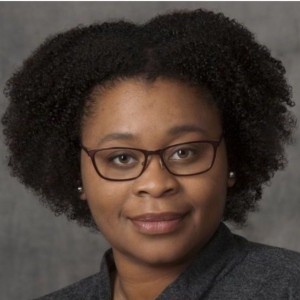
That funding will go not only toward capital needs, Tolbert said, but also toward planning, to help churches understand how to undertake preservation. Matching grants will help churches create new preservation endowments so that invested income can be used to support maintenance and preservation of existing buildings. Emergency grants are also available to address immediate issues such as damage caused by floods, fires and even acts of vandalism.
And the Action Fund is working with six churches — four in Alabama and one each in California and Chicago — to help develop comprehensive stewardship plans that will address restoration and rehabilitation of the buildings along with programming and interpretation, activating space for community, and bringing in arts and social justice programs. They will benefit from a consulting team of architects, engineers, business planners and capital campaign fundraisers.
“It is essential that these places are activated,” Tolbert said. “They are centers of worship, but also, they continue to serve the community.”
Action Fund executive director Brent Leggs told The Washington Post in an interview that Black churches are exceptional lenses through which to view Black and American history. “It’s amazing to see centuries of Black history told at historic Black churches. Some of the stories include formerly enslaved Africans moving through emancipation, beginning to form communities, … and some of the earliest buildings founded by African Americans in the United States [include] a Black church. These places are of exceptional significance. Their stories matter, and they are worthy of being preserved.”
Would members of your community benefit from learning more about your congregation’s past and its role in local history?
Questions to consider
- It’s commonly said that the church is “more than the building,” yet buildings are material remnants of history and culture. What kinds of meaning do church buildings have for you?
- Does your church have a historic role in your community? How has its role changed over the years?
- Steeples are a traditional element of many churches, yet they can be difficult to maintain. What traditional elements of your church are difficult to maintain? Would your congregation be OK without them?
- If you were asked what in your church is worth preserving, what would you say? What would your congregation say?
- How is your space “activated” for your community? Would members of your community benefit from learning more about your congregation’s past and its role in local history?
What does having a financially sustainable ministry mean? The one-size-fits-all answer is simple. The revenue coming in is consistently more than the expenses going out. But this simple answer obscures the gap between those benefiting from generations of building wealth and those in Black and brown America who have had wealth stolen across the years. Calculating sustainability needs to account for this gap.
I hope that the current pandemic, economic recession and renewed attention to racial inequity is teaching those in the dominant culture that one size does not fit all. When “we” talk about money, the field is never level.
African Americans were treated as property for generations while white Americans were acquiring land and accumulating money. The starting places for families in these communities today is not equal. Whenever we discuss financial sustainability, we have to examine the conditions that create, or that make it difficult to create, wealth.
Sustainability is a sought-after goal in new-program development. In financial terms, it refers to developing revenue sources that provide funding to keep the program going. Sometimes it is as simple as one funder asking the program to find other donors. Sometimes it means adding fees to the service or getting somebody else’s budget to pay the cost. Often it includes reducing the cost of the service to match the expected revenue.
As a white leader in a dominant-culture organization, I hear the talk about making adjustments and raising more money — and it all seems doable. The pandemic has thrown up a roadblock, so reaching sustainability will likely take more time, but “we” believe that “we” can be back to normal in six months or a year. A few think that “we” are in for a decade of economic difficulty.
The use of “we” covers up the different experiences in different communities. When listening to colleagues in organizations founded by and rooted in African American and Latino/a communities, I recognize that they hear talk of sustainability differently. They have learned to say what funders want to hear, but they translate the words into a different set of actions.
For example, I have encountered a handful of organizations in these communities that recently had applied for but did not receive a $1 million grant to serve pastors. Most of these organizations moved forward to develop and deliver as much as they could of the proposed program without the money. How? Mostly through unpaid labor. People affiliated with these organizations took on a second (and sometimes third or fourth) job to serve pastors. In economic terms, these organizations were investing sweat in place of money in order to do what was both most important and possible.
In financial terms, it looks as if these programs are doing great. In fact, they don’t seem to need the grant money. But when we listen to their stories, it is clear that valuable ministry is being performed by exhausted leaders.
The white-culture organizations where I have worked talk about priorities. These organizations have the privilege of deciding how to serve according to the financial resources available. But I have observed many organizations that are part of African American and Latino/a communities prioritize according to the needs of their communities and the world. The leaders of these organizations do what is needed regardless of the money.
How can I learn from this dedication and not participate in taking advantage of it? One element of privilege is not recognizing the impact of categories like sustainability on those without privilege.
This realization has made me more careful when planning a collaborative project with organizations from different cultural, racial and ethnic communities. For example, I now ask partners about pay equity across the project for the same work. I don’t assume that because employees at my white, dominant-culture organization are paid a fair wage, all the collaborating organizations are able to do the same. How do we plan the project so that people are paid equitably?
In fact, the concern starts in the planning phase. What creates the conditions so that all the organizations involved in planning a project have the resources to do the planning? Those with wealth have the option of choosing to shift their efforts to a new project. Those with no resources have to double up on their work to do something new.
If a project is underway, what would it be like to count the labor of these leaders as part of sustainability? What would it be like for donors to see that they are matching a contribution of labor and recognize that effort as part of sustainability?
What would happen if donors recognized the vast disparity between the assets accumulated by white-dominant organizations and white families when compared with African American and immigrant institutions and families? What if the funding levels were calibrated to address these disparities? What would happen if organizations in these communities had significantly longer to develop sustainability plans for donors?
In the midst of economic challenges, more complex and nuanced definitions of sustainability need to be used. All who donate and benefit from donations can learn to pay attention to the needs in communities, as well as who can be supported to address these needs. Moving too quickly to asking a program to “pay for itself” can continue a cycle that takes resources away from long-disadvantaged people.
As a white leader, I must learn more about the challenges faced by my colleagues in different racial, ethnic and cultural communities and advocate for adjustments that provide a path to more equity. I must not leave all the weight for making this case on these leaders.
The COVID-19 pandemic will surely have a long-term impact on the financial life of congregations, regardless of their denomination, size or makeup. How can churches survive and even thrive in a post-pandemic landscape?
Faith & Leadership asked 12 church and ministry leaders in a variety of contexts across the country to share their views of the future.
Contributors
Click a name to jump directly to that contributor’s response.
• David P. King
• Bill Wilson
• Prince Raney Rivers
• Laura Everett
• Reginald Blount
• J. Phillip Martin
• Gerardo Marti
• Elise Erikson Barrett
• Brian Kluth
• Josephine Everly
• Tim Wishon
• Mark Ramsey
They spoke about matters of dollars and cents — the need for online giving, for example. But they went beyond that, reflecting on the broader challenges and shifting roles facing churches on the other side of the pandemic.
No one knows the answers. But the question, as one participant put it, is clear: “Is this the death of the church or the rebirth?”
‘Making your case’
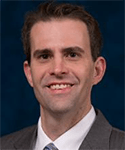 David P. King
David P. King
Karen Lake Buttrey Director
Lake Institute on Faith & Giving
Indianapolis, Indiana
The Lake Institute on Faith & Giving had been preaching about the importance of addressing money in theological terms long before the pandemic. Now more than ever, said institute director David King, churches that shy away from the subject do so at their own risk.
“The time for being humble and shy in making your case is over,” King said. “The time for talking about money as if it’s taboo in a congregation should also be over.”
The Lake Institute is part of the Indiana University Lilly Family School of Philanthropy at IUPUI. Its 2019 National Study of Congregations’ Economic Practices found that revenue growth was more prevalent among congregations that regularly discussed the theological importance of giving through sermons, money management classes and the like.
For example, 12% of the 1,200 congregations surveyed indicated that they addressed financial matters monthly. Of those churches, 73% reported increases in revenue.
It is crucial, King said, for churches to lift up online giving not just as a convenience but as a theologically sound way to give. The 2019 study (reflecting 2017 data) found that 46% of churches offered online giving — a number that likely has risen with the recent shutdown — but that 78% of revenue still came through worship.
Managing how people give, King said, isn’t as pivotal as articulating why their giving is a vital part of a life of faith. The pandemic just raised the stakes.
“On any day, but particularly today,” he said, “religious leaders avoid at their own peril the full lives of those entrusted to their care.”
‘Local churches can lead the way’
 Bill Wilson
Bill Wilson
Director
The Center for Healthy Churches
Clemmons, North Carolina
Bill Wilson predicts that up to one-third of U.S. churches could be out of business by 2025.
He points to LifeWay Research that says 5% of U.S. churches will close within the year because of the pandemic. That’s five times the average closure rate for churches, according to The Christian Century magazine.
Wilson, who directs The Center for Healthy Churches, acknowledges that this is all conjecture, given the unprecedented nature and unknown length of the pandemic shutdown.
His best guess is that churches will suffer a 33% decline in giving in 2020, in part because there was no live Easter offering. It’s possible that the traditional surge in giving in December will help make up for lost ground, he said, but there’s no way to know.
Drawing on his experience with his organization, which has worked with several hundred churches during the past decade, Wilson estimates that one-quarter to one-third of churches operate on thin or no reserves.
Yet despite evidence of a looming financial disaster, he remains hopeful that the church can rise to the occasion.
In a March 18 post on the center’s website, he wrote: “The Church has an opportunity to show the world what healthy people do in times of crisis. Rather than panic and devolve into self-absorption and self-protection, we run toward the needs in our culture rather than away from them. We refuse to demonize others, but act out the story of the Good Samaritan on a daily basis. Local churches can lead the way to show their communities what ‘love your neighbor as yourself’ actually looks like.”
Wilson believes that our response to the crisis will help determine what happens next. “Is this the death of the church or the rebirth?” he said. “We’ll see.”
‘What are we not doing?’
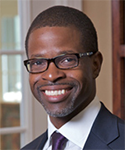 Prince Raney Rivers
Prince Raney Rivers
Senior pastor
Union Baptist Church
Durham, North Carolina
As pastor of a 5,000-member church and third vice president of the General Baptist State Convention of North Carolina, the Rev. Prince Rivers takes a short and long view of the shutdown.
In the short term, Rivers said, churches need to appreciate the importance of adopting online giving if they haven’t already, and convince members that it’s a viable alternative to the Sunday offering.
That may be a particularly hard sell in the African American faith community. According to the Lake Institute’s 2019 National Study of Congregations’ Economic Practices, African American congregations receive 88% of their revenue through worship services, compared with 78% for all congregations.
Rivers said that giving lagged at his church during the shutdown until they scheduled times for members to drive by and drop off their offerings. Many people do not feel comfortable giving online or even mailing their checks, he said. They want to practice the physical act of giving at the church.
Taking a longer view, Rivers believes that sheltering in place will stir churchgoers to more deeply affirm the value of worshipping shoulder to shoulder, “the significance of gathering people together and building relationships you can depend on,” he said.
As the shutdown forces churches to examine their ministries and programs in terms of cost, Rivers hopes it also inspires them to reexamine, in a more profound way, how best to serve Christ.
“What do we really need to bring back?” he said. “And what are we not doing that we need to put more energy in?”
After the pandemic, Rivers hopes congregations will take a broader view that looks beyond their own steeples. His prayer? As we have sheltered in place as one, may we return to everyday life as one, bound by our hopes and needs, regardless of gender, color, class and culture.
‘Terrified of what the church might be …’
 Laura Everett
Laura Everett
Executive director
Massachusetts Council of Churches
Boston, Massachusetts
Amid the current uncertainty, Laura Everett of the Massachusetts Council of Churches said she is certain only of her fear: “I am terrified of what the church might be on the other side of this. I am terrified that we will come out on the other side of this and there will only be wealthy churches.”
She calls the pandemic and its aftermath “apocalyptic,” revealing what she characterizes as “the great divide in the body of Christ.”
There are wealthy churches with strong financial reserves and the ability to survive even COVID-19, she said. Then there are smaller, struggling churches whose members now and in generations past have been held back by racial and economic injustice.
If the wealthy don’t reach out beyond their congregations, denominations and narrow self-interest to help the poor and vulnerable, she believes, these marginalized churches will suffer — or die.
Christians should understand that God’s economy is not the coronavirus economy, Everett said.
“We believe there is enough,” she said. And so the challenge is to share what we have with those who need it most — to live up to that yearning expressed in John 17:21, “that they may all be one.”
And if the church fails to do this?
“If we only take care of our own,” Everett said, “how can anybody trust us?”
‘How is it with your soul?’
 Reginald Blount
Reginald Blount
Assistant professor of formation, youth and culture
Garrett-Evangelical Theological Seminary
Evanston, Illinois
Reginald Blount says he is optimistic yet pragmatic about what the church might look like when it returns to a new normal.
He believes that virtual ministry will play a more powerful role, to the point that everything except Sunday worship will be conducted online.
He anticipates that churches will still be calming the fears of members 18 to 24 months from now, including those who will be dealing with post-traumatic stress disorder (PTSD). He hopes churches will expand their pastoral counseling and mental health outreach.
Noting that COVID-19 has hit black and brown communities especially hard, Blount wants churches to address personal health — exercise, hypertension and other challenges.
But he also wants them to address public health issues. Why do African American and Latino communities lack easy access to full-service grocery stores with ample fresh foods? Why don’t the poor have equal access to health care?
While on sabbatical this semester, Blount is studying the impact of current economic dynamics on African American churches, focusing on inequities in access to financial resources.
In addition to his academic work, Blount is senior pastor of the 150-member Arnett Chapel AME Church in Chicago. The challenge for his congregation and others, he said, is how to touch members without actually touching them.
Arnett Chapel AME is emphasizing FaceTime, phone calls and letter writing — not email, but old-fashioned pen to paper.
Blount is sending out a robocall to his congregants twice a week with a devotion or simple word of encouragement, “for the members to be able to hear their pastor’s voice,” he said.
His church hopes to revive the old Methodist tradition of class leaders — laity assigned to reach out to church members.
The question they will ask is the question we are all asking one another these days: “How is it with your soul?”
‘How long is our memory?’
 J. Phillip Martin
J. Phillip Martin
CEO
The Church Network
Richardson, Texas
When the pandemic hit, The Church Network offered its 1,500 congregations three pieces of advice:
- Take a deep breath.
- Communicate regularly to your church members about worship, giving, the status of ministries, meetings and more.
- Offer alternative ways to give.
This Texas-based interdenominational organization is made up largely of church administrators, so its focus during the pandemic has been on economic survival, said J. Phillip Martin, the network’s CEO.
Beyond that initial advice, Martin is urging congregations to launch or enhance online giving platforms.
One suggestion, from Discipleship Ministries of the United Methodist Church, is for churches to send out regular emails on Saturday evenings or Sunday mornings reminding those watching online — or not watching at all — to give, Martin said.
He hopes that church leaders now see the need to build up reserves for the next crisis that puts church life in peril. Should you have a month’s worth of money in the bank? A year’s worth? These questions can no longer be tabled for another day, Martin said.
He also encourages congregations to be open to innovation. Many churches have found ways during the pandemic to care for the homebound via Skype and Zoom. Congregations should continue to look for fresh ways to preach and live the gospel virtually — worship, pastoral care, education. Certainly, this approach will speak to youth and young adults, the two demographics the church is losing in greatest numbers.
Churches can go in one of two directions after the pandemic, Martin said. They can find ways to be more stable in administration and innovative in ministry, or they can ignore the lessons of the pandemic and go back to business as usual.
“The question,” he said, “is, How long is our memory?”
‘I could be wrong, right?’
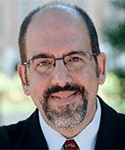 Gerardo Marti
Gerardo Marti
Professor and chair of sociology
Davidson College
Davidson, North Carolina
Gerardo Marti sees trouble ahead in the immediate days following the shutdown.
Churches with limited credit and fixed costs — mortgages, leases, maintenance — will have little room for financial flexibility. Marti foresees church attendance dropping when live worship returns, especially among occasional attendees.
With that, he anticipates a decline in giving. Ambitious plans, whether reflected in new ministries or in new or improved facilities, will have to be put on hold while churches worry about more immediate issues.
How much staff do we need and can we afford? How many chairs should we put out for worship?
With that narrow focus, innovation will likely grind to a halt, said Marti, who is co-author of the book “The Glass Church,” about the financial collapse of Robert H. Schuller’s megachurch, the Crystal Cathedral.
For example, a profound church innovation of the late 20th century was the start of contemporary worship. That sort of bold step, which draws newcomers and engages regulars, will give way after the crisis to a focus on returning to some level of normalcy, he said.
If any churches not only survive but perhaps prosper, Marti said, it may be the smaller Pentecostal and nondenominational evangelical congregations, those with fewer than 300 members. This size and style of church strikes a particularly strong chord in the Latino community, he said.
Their smaller size generally means they have less infrastructure, less fixed debt for capital projects, maintenance and the like, and are less dependent on a higher-up body for financial support. These congregations, already comfortable living on a shoestring, may be best positioned to continue their ministries with a fervor unaffected by COVID-19.
Given that all of this is uncharted territory for churches and the rest of society, Marti is quick to add a warning to his forecast: “I could be wrong, right?”
‘Unlock some different kinds of creativity’
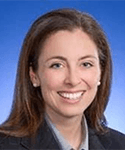 Elise Erikson Barrett
Elise Erikson Barrett
Coordination program director
National Initiative to Address Economic Challenges Facing Pastoral Leaders
Indianapolis, Indiana
Elise Erikson Barrett fears that COVID-19 will force already struggling churches to lock their doors five to 10 years earlier than they otherwise might have. But at the same time, she hopes that it will stir those churches to seize this unprecedented opportunity to embrace change.
Barrett directs a program to help pastoral leaders facing economic challenges. The initiative, funded by Lilly Endowment Inc., supports 43 grantee organizations, stewarding projects to equip pastoral leaders for financial literacy and leadership, as well as providing direct economic aid.
Many pastoral leaders engaged in the grant programs are men and women of color who lead small, rural congregations. Many struggle to meet payroll and keep the doors open.
When the shutdown is over, Barrett believes, there are at least two ways such churches can respond: offer a long, slow resistance to change, mired in the legitimate grief of losing the way church has always been, or rally around the need for dramatic change and identify what Barrett calls a church’s core purpose.
How might a church choose the latter? Become more focused on mission outside the church rather than difficulties within the church, Barrett said. Be willing to adapt, whether that involves the size and responsibilities of church staff, how the buildings and campus are used, or how the church can make itself invaluable to its neighbors.
Each church’s story — past, present and future — is different. But on the other side of sheltering in place, Barrett sees a blank canvas waiting for God’s people to bring it to life.
“This,” she said, “can unlock some different kinds of creativity.”
‘Many of our idols have fallen’
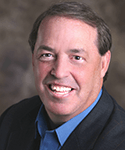 Brian Kluth
Brian Kluth
Director of NAE Financial Health
National Association of Evangelicals
Denver, Colorado
Brian Kluth, who lectures and writes about generosity and finances in churches, foresees four options for churches faced with a difficult decision after the pandemic:
- Merge with one or more other congregations.
- Become a satellite campus of a larger church.
- Transform into a house church, where remaining members meet in each other’s homes.
- Close and disband.
Even churches that survive will have to examine giving and make adjustments in payroll, facilities and programs, he predicts.
Drawing on 2015 research by the NAE Financial Health initiative, Kluth said it’s inevitable that many churches will face wrenching choices. The median annual church budget in the United States is $125,000.
Such churches, Kluth said, have little margin for a decline in giving, especially if they lack online giving and livestream capabilities.
Kluth is worked with a number of national organizations and ministries to conduct an online poll of church leaders to gauge the economic impact of the pandemic. The poll indicates that about six out of 10 churches have seen a drop in giving.
But rather than seeing the pandemic solely as a crisis, Kluth sees it also as an unexpected sabbatical season, free of distractions, with time for churches and their members to search their souls.
“Many of our idols have fallen in this season,” he said, citing sports, shopping and travel. “We have to reassess what our commitment is to God and to our families. It’s no longer about the big Sunday production but how we [show] care and love for people.”
In that sense, he said, the pandemic shutdown can be a gift from God.
‘A true digital stewardship’
 Josephine Everly
Josephine Everly
Chief development officer
Leadership Roundtable
Washington, D.C.
In her role with Leadership Roundtable, Josephine Everly helps U.S. Roman Catholic parishes, schools and missions with strategies for raising funds, building endowments and engaging donors.
And she has experience dealing with the aftermath of a crisis. Having grown up in New Orleans, she brought a personal passion to managing disaster-relief giving after Hurricane Katrina.
Everly believes that it will be 18 to 24 months before parishes, schools and other Catholic institutions see a return to normal levels of giving.
With so many parishioners facing possible layoffs and declining investments, it will likely take that long for many donors to recover from the pandemic, she said.
Everly anticipates closings and consolidations among Catholic institutions, especially in communities on the margins.
She knows of 13 U.S. Catholic parishes that launched online giving in the first week of the pandemic. But giving remotely is a tough sell for Catholics, she said, because the seven sacraments of the Roman Catholic Church, including Holy Communion, are shared within the four walls of the church.
The physical act of passing the plate at Mass, she said, is a deeply spiritual experience that cannot be replicated online. Nor can mailing a check provide the same experience.
Her counsel?
The church must expand digital giving but also expand how it shares the word of Christ online, offering the broader, deeper spiritual experience for which Catholics yearn — or at least the next best thing.
“A true digital stewardship,” she said, “does this.”
‘I gave online’
 Tim Wishon
Tim Wishon
Church administrator
Carmel Baptist Church
Matthews, North Carolina
Tim Wishon oversees the business side of a megachurch with the resources to survive the pandemic.
Carmel Baptist has 5,000 members, an average of 2,500 worshippers at Sunday’s three services and a $10 million annual budget — $23.6 million if you include its K-12 private school and preschool.
But the church has a challenge in common with smaller churches: convincing members that giving online can be as meaningful a part of their faith life as dropping a check or envelope in the offering plate.
The church has robust, cutting-edge technology, from online giving to the livestreaming by which Carmel has been reaching its congregation during the pandemic.
Carmel’s constituency is largely suburban, middle-aged and professional. Members are comfortable living their lives online.
And yet, Wishon reports, 50% of the church’s giving pre-quarantine was put in the plate on Sunday mornings. Another 35% was mailed in, and 15% came in online.
Passing the plate endures as a powerful, sacrificial act, he said, from farmers offering fruits and vegetables generations ago to children tithing part of their weekly allowance today.
Still, the pandemic may at least have introduced people to the ease of giving online. Post-quarantine, 45% of Carmel’s giving has been online, Wishon said. But 55% still comes the old-fashioned way — through a check in the mail.
For those who need a little help in the long term pivoting away from a tradition as sacred to them as a hymn, Wishon has a suggestion. When Sunday worship returns, churches can provide cards bearing a simple statement for members to put in the offering plate: “I gave online.”
‘A gut-check moment’
 Mark Ramsey
Mark Ramsey
Executive director
The Ministry Collaborative/Macedonian Ministry Foundation
Atlanta, Georgia
The message of the church must be bigger than “We’ve reopened the doors, and the machine is up and running,” said Mark Ramsey, the head of a ministry that offers pastors a chance to meet with peers.
Yes, churches will have to become leaner organizations after the pandemic. And it’s not just small churches at risk, he believes. Larger churches with big buildings and big staff will face big financial challenges, too.
All churches will have to inspire people who have worshipped online for months to return to the church on Sunday mornings.
But if the church doesn’t seize the moment and examine the essence of its place in this world, do matters of finance matter?
“If the church feels like my homeowners association in how they do things and what they offer,” Ramsey said, “what’s the point?”
Lessons learned must go beyond how to livestream a funeral. People are frightened. Our way of life has been turned upside down. Now is the time for the church to reintroduce itself as a place of care, connection, community and depth, he said.
“God loves the church,” Ramsey said. “But God loves the world more. Do whatever you can to love the world now, and don’t worry about your infrastructure. If churches focus on the money, they’re going to have a hard time. If they focus on what they can do culturally, I think they’ll have a fighting chance.
“I think this is a gut-check moment,” Ramsey said. “Can churches really love into that?”
Additional Resources
Most houses of worship, denominations, seminaries and other faith-based institutions are sharing on their websites a broad offering of resources and reflections on COVID-19. Here are four that are featured in this article.
The Church Network: This national association focuses on church administration. Its COVID-19 presence offers church and government resources and articles.
Lake Institute’s National Study of Congregations’ Economic Practices: This 2019 survey of 1,200 congregations explores financial practices relevant to the current crisis.
Leadership Roundtable: This Roman Catholic organization offers leadership, pastoral and government resources for the COVID-19 crisis.
Massachusetts Council of Churches: This site has resources related to public health and doing the work of the church (funerals, finances, pastoral care and more) during the shutdown.
Sustaining a program is a heavy burden. The program may bring in less money than it spends. Some constituents may question its worth. Additional funding sources when grant money runs out can be difficult to find. Plus, sustaining a program means meeting people’s future needs, which can be hard to predict.
The urgency of discerning how to sustain a program forces leaders to examine every detail: Could we charge more? Do we have to serve lunch? Could the program be shorter? What elements are costing us the most? Could we trim those larger expenses?
If such adjustments to revenue and expenses are possible, congratulations! But for many Christian leaders, the overall budgets of our organizations are so constrained that the minor adjustments we are free to make might not result in sustainability. In these cases, assuring the long-term effects of a program requires revisiting foundational questions about its purpose and impact. For example:
- What constituents does this program serve? What needs does it meet?
- How do constituents say this program helps them? How does it change the way they do their work?
- Why is the program important to the organization offering it? How it is aligned with the organization’s mission?
These questions must be answered at an institutional level, but they are individual questions, too. Why is this program important to you? How is it related to your vocation and the vocations of your key program leaders? Would the program fall apart if you or another team member left? Does the institution’s senior leadership support this program, now and into the future?
With a clearer sense of the program’s purpose and impact, it is time to envision and plan various scenarios. I find it helpful to peel apart the question of sustainability by looking at what is required to sustain specific program elements. For example:
- What is required to continue the most significant and high-impact activities?
- What is required to continue the jobs the program created?
- What is required to support constituents and outside partners?
- What is required to sustain the ways of thinking, feeling and working the program is encouraging?
Almost 20 years ago, I was part of a grant-funded program to support pastors in my newly formed denomination. As the team evaluator, I was responsible for stepping back from the day-to-day and helping articulate the difference the program was making.
Initially, our focus was on how the program’s activities — the peer groups, sabbaticals and seminary graduate residencies — were affecting the people involved. Participants reported that the activities were life changing, but the donors we pursued were not excited about funding the program.
After a few years of asking questions, our team realized that sustainability was less about the activities of the program and more about a shift in mindset for congregations and clergy.
Our new denomination had inherited from its predecessors a view of pastors as replaceable parts. When a congregation felt disappointed with any aspect of the pastor’s leadership, the easiest adjustment was to simply replace the pastor. That denomination had large seminaries that graduated hundreds of pastors each year. There were plenty of available replacements.
We began to see our program’s goal as encouraging congregations to see pastors as renewable and renewing. The metaphor we used was that a congregation was a garden and the pastor a plant that both needed and provided nurture. The program would be sustainable, we realized, when congregations began changing policies to grant sabbatical time and increase continuing education funds. We hoped to see clergy forming peer groups without the encouragement of money.
In our case, sustainability was not determined by fundraising. We were hoping to see shifts in behavior and priorities — a purpose we recognized only by asking questions about impact from multiple points of view.
In this story, I have the advantage of 20 years of hindsight. Developing sustainability plans seldom has such a clean narrative. In the early years of a program, I have benefited from using these first, foundational sets of questions to gain information and then formulate a few scenarios. In the case of my denominational pastor program, those scenarios might include:
- What if every pastor had a mentor? How would pastors need to be supported to engage in such relationships? Who would provide such support, and what would the cost be?
- What if every congregation provided sabbaticals to its pastors? What conditions would be required to support such time away? Who would need to support such efforts, and what would that look like?
Each “what if” question generates a plan. Those planning for sustainability are working to encourage the desired conditions while also watching for evidence that they are being achieved. Over time, the individual scenarios begin to come alive. Eventually, the scenarios can be combined to create a single plan for sustainability.
Sustainability planning requires intentional time and space. I recommend setting aside time at least twice a year to update answers to key questions and revisit the scenarios being considered.
Don’t do this work alone; sustainability is a team activity. Program leaders are most often responsible for raising the questions, gathering information and suggesting alternatives. But the work of future planning necessarily includes your team, participants and stakeholders. The more a program can engage its constituents and institution in the process, the better.